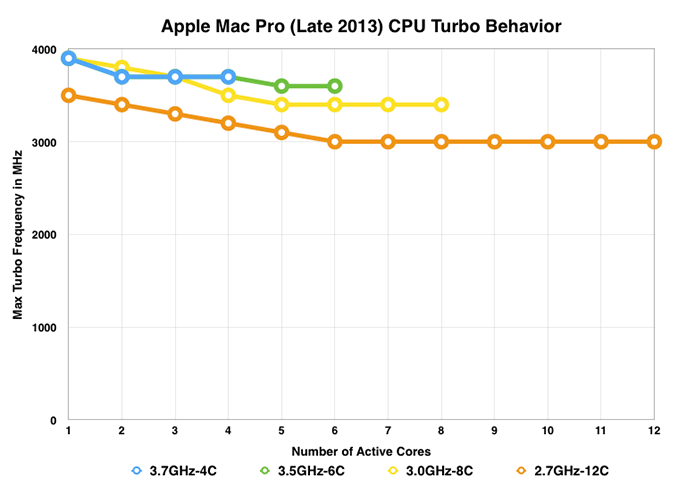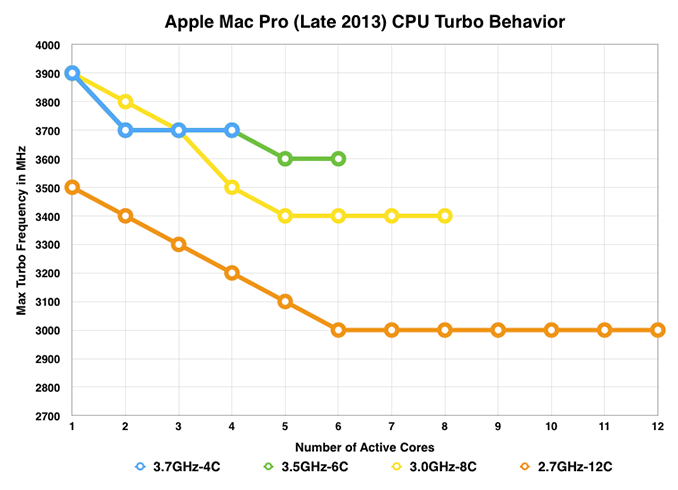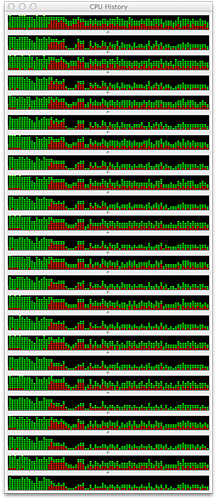The Mac Pro Review (Late 2013)
by Anand Lal Shimpi on December 31, 2013 3:18 PM ESTCPU Choices
Had I gotten around to publishing my rMBP review prior to this one you would’ve seen my praise Apple’s CPU selection abilities as of late. Outfitting all 15-inch rMBPs with Crystalwell was a very wise move on Apple’s part. With the Mac Pro the CPU selection is good, but the decision of what to buy is far more complex than in any other product line.
The Mac Pro not only serves as Apple’s ultra high end Mac, but it’s the only option if your needs exceed that of an iMac or 15-inch MacBook Pro. Literally anyone who needs more performance than Apple offers in an all-in-one or a notebook inevitably is pushed to consider the Mac Pro. With a relatively broad professional audience in mind, Apple offers more CPU options for the Mac Pro than on any other shipping Mac:
| Mac Pro (Late 2013) CPU Options | ||||||
| Intel CPU | Xeon E5-1620 v2 | Xeon E5-1650 v2 | Xeon E5-1680 v2 | Xeon E5-2697 v2 | ||
| Cores / Threads | 4 / 8 | 6 / 12 | 8 / 16 | 12 / 24 | ||
| CPU Base Clock | 3.7GHz | 3.5GHz | 3.0GHz | 2.7GHz | ||
| Max Turbo (1C) | 3.9GHz | 3.9GHz | 3.9GHz | 3.5GHz | ||
| L3 Cache | 10MB | 12MB | 25MB | 30MB | ||
| TDP | 130W | 130W | 130W | 130W | ||
| Intel SRP | $294 | $583 | ? | $2614 | ||
| Apple Upgrade Cost (Base Config) | - | +$500 | +$2000 | +3500 | ||
| Apple Upgrade Cost (High End Config) | - | - | +$1500 | +3000 | ||
There are four CPU options, each with varying core counts. The more cores you get, the lower your base CPU frequency is. In the old days, that would be the end of the discussion - you either choose more cores or more frequency, a tradeoff that is ultimately determined by your workload. Starting with its Nehalem architecture back in 2008, Intel introduced two key technologies that changed the face of multicore on the desktop: power gating and turbo boost. The former is a technology that can almost entirely remove power to a core (both active and leakage) when idle, while the second takes advantage of that freed up thermal budget to drive any active core(s) at higher frequencies. Subsequent implementations of Intel’s Turbo Boost technology have scaled the aggressiveness of this opportunistic frequency scaling, but the basic principle remains the same.
Apple advertises core count and base frequency for all of the Mac Pro CPU options, but to really understand what you’re getting yourself into you need to look at each CPU’s max turbo states vs. number of active cores. Neither Apple nor Intel do a great job of publicly exposing this information, Apple avoids doing so in order to keep things clean/simple, and Intel avoids doing so because perhaps it’s fun? Either way I’ve compiled the data on the four CPU options into the charts below.
I've left base clocks out of the graphs although you can see them noted in the legend at the bottom of each chart.
This first chart has the y-axis starting at 0MHz, but the next one is the more interesting as it starts at 2.7GHz and better illustrates/exaggerates the sort of frequency tradeoff you can expect vs. core count:
The 4, 6 and 8 core CPU options all offer the same peak single core frequency (3.9GHz). This is very important as single threaded performance remains the gate for system responsiveness outside of thread heavy applications. The 12-core CPU sacrifices around 10% of this peak single core performance.
Early on the 8-core CPU holds the advantage over the rest, being able to hit a higher 2-core max turbo. The octa-core’s crossover point happens at 3 active cores, beyond this point the quad and six core CPUs maintain a slight max turbo advantage.
The key takeaway here is that more cores isn’t necessarily better. You need to weigh the needs of your applications against the number of cores in your system. There is no one-size-fits-all answer here. For kicks I looked at the CPU load for a handful of my benchmarks:
![]()
![]()
![]()
Application version seems to have a huge impact on threading. Running our Photoshop benchmark on CS5 vs. CS6 is the difference between loading 2 - 8 cores vs. 3 - 10. The same is true if I compare Final Cut Pro 10.0 vs. 10.1; the latest version from Apple (optimized for the new Mac Pro), makes great use of all 12 cores/24 threads. Workload also has an impact. I took our old Final Cut Pro 10.0 benchmark (1080p) and ran it on 10.1, saw a maximum of 1217% CPU usage. I ran our new 4K benchmark on 10.1 and saw nearly full virtual core utilization (2114% CPU usage).
![]()
Final Cut Pro 10.0 - 1080p Benchmark
![]()
Final Cut Pro 10.1 - 1080p Benchmark
![]()
Final Cut Pro 10.1 - 4K Benchmark
Offline 3D rendering applications typically have the easiest time of chewing up tons of cores, while many others are likely better suited by having fewer cores running at a higher frequency. There's also a serious multitasking benefit if you're the type of person that runs multiple thread heavy workloads in parallel. It's pretty nice having a fairly responsive system while rendering a beefy 4K project in Final Cut Pro. The responsiveness comes courtesy of having a ton of cores in addition to extremely fast IO. That PCIe SSD definitely comes in handy.
If you want the best balance of heavily threaded performance without sacrificing performance in lighter workloads, the 8-core configuration seems to be the best bet. There are definitely bragging rights associated with the 12-core system, but unless you absolutely need a ton of cores you’re likely better suited by the 8-core configuration.













267 Comments
View All Comments
estern53 - Monday, January 6, 2014 - link
Now all we need Apple to do is make a prosumer version of the Mac Pro for under 2k for the rest of us.wheelhot - Monday, January 6, 2014 - link
They already did, it's called the iMac, or MacMinitipoo - Monday, January 6, 2014 - link
A Mini redesigned as a mini version of this might be cool, especially with a discreet GPU.affinityseattle - Wednesday, January 8, 2014 - link
The LR test is a bit off. LR is not great at exporting. As a pro, I've found the trick is to stack export processes. The more cores you have, the more it can handle and utilize the CPU. So, the iMac i5 might be faster on a single export, but the Mac Pro should spank it if you start dividing the export up. Also, if you have a 1000-image export, the imac and mbp will overheat and reduce the CPU power (TLD). For a pro machine, these types of usage are relevant.GRAFiZ - Wednesday, January 8, 2014 - link
It's an impressive product... but, as with most Apple designs, form is first, function is second. The fact that it has to scale CPU speed to reduce heat says all I need to know. Obviously the Apple fanbois will argue "THATS A THEORETICAL SITUATION!!!" but who cares? The fact is I'm buying brand new parts at the highest premium on the market... thermal throttling should NEVER EVER be necessary.Bottom line, like all Apple products, it's impressive... but, you can do better for less money elsewhere.
DotFab - Wednesday, January 8, 2014 - link
You've read it all wrong!The work load that put the MP under slower run was purely artificial.
It's not anything actual programs run.
The conclusion to draw is that the global thermal dissipation is great!
You missed the point of the test.
lukarak - Thursday, January 9, 2014 - link
You clearly don't care, but people who will actually use it, will care that it won't throttle down when they load it.Only haters care about a situation that will never take place. As they can, in their frustration and insignificance, gloat about something.
GRAFiZ - Thursday, January 9, 2014 - link
No hater here... I just think it's poor design that a brand new product, costing as much as TEN THOUSAND DOLLARS can not handle a theoretical max load without overheating.I can build a dual octa-core Xeon E5v2 system for far less that could process the same simulated work load without any thermal of processor speed restrictions at all.
But, I guess if you want the smallest little desktop made, it's really your only choice. I just find it funny that when you spend as much as a brand new car might cost on a desktop computer, that any such limitations would need to be accepted at all.
wordsofpeace - Friday, January 10, 2014 - link
If Apple had made it 10mm wider and maybe 20mm taller, the extra thermal capacity could have allowed more headroom. But no, it had to be 9.9" x 6.6" and 11lbs. It's almost as if the marketing dept. decided on the most wow factor specs and poor old engineering had to come up with a solution.Don't get me wrong, I'd love one on my desk, but I too don't understand Apple's addiction to form over function.
tsk2 - Thursday, February 20, 2014 - link
I share your view. I enjoy my mac pro 2008 (packed with all the stuff I need) and a nice cinema display. Sure, both are big, but they both look nice and I don't feel limited. I have tried small nice looking boxes in the past and my experience has always been that it is a lot of effort to expand, add cables, and still get that uncluttered feel. A bigger box, I can live with, but this solution, albeit "initially" good looking, is too short term. I wish Apple would notice that there are users who fall in our category..